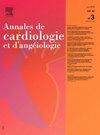阻塞性睡眠呼吸暂停和房颤-机制、诊断和治疗
IF 0.3
Q4 Medicine
引用次数: 0
摘要
阻塞性睡眠呼吸暂停综合征的特点是反复气道阻塞导致间歇性缺氧和睡眠破碎。它是心房颤动的主要独立危险因素,心房颤动患者中阻塞性睡眠呼吸暂停的患病率很高。其病理生理机制包括间歇性缺氧引起交感神经激活和心房重构,以及胸内负压波动促进心律失常。诊断依赖于多导睡眠图和标准工具,如SCOPER系统。持续气道正压通气是标准的治疗方法,对房颤的进展和复发有有益的效果,尽管研究结果各不相同。阻塞性睡眠呼吸暂停和心房颤动的综合管理,包括体重控制,对优化临床结果至关重要。需要进一步的研究来更好地确定患者亚组并评估不同的治疗方案。本文章由计算机程序翻译,如有差异,请以英文原文为准。
Syndrome d'apnée obstructive du sommeil et fibrillation atriale - mécanismes, diagnostic et traitement
Obstructive sleep apnea syndrome is characterized by repeated airway obstructions leading to intermittent hypoxia and sleep fragmentation. It is a major independent risk factor for atrial fibrillation, with a high prevalence of obstructive sleep apnea among patients with atrial fibrillation. The pathophysiological mechanisms include intermittent hypoxia causing sympathetic activation and atrial remodeling, as well as negative intrathoracic pressure fluctuations that promote arrhythmia. Diagnosis relies on polysomnography and standardized tools such as the SCOPER system. Continuous positive airway pressure is the standard treatment and has shown beneficial effects on atrial fibrillation progression and recurrence, although study results vary. Integrated management of obstructive sleep apnea and atrial fibrillation, including weight control, is essential to optimize clinical outcomes. Further research is needed to better identify patient subgroups and evaluate different therapeutic options.
求助全文
通过发布文献求助,成功后即可免费获取论文全文。
去求助
来源期刊
CiteScore
0.60
自引率
0.00%
发文量
68
审稿时长
6-12 weeks
期刊介绍:
Organe scientifique de référence fondé en 1951, les Annales de cardiologie et d''angéiologie abordent tous les domaines qui intéressent quotidiennement les cardiologues et les angéiologues praticiens : neurologie et radiologie vasculaires, hémostase, diabétologie, médecine interne, épidémiologie et prévention.
Les Annales de cardiologie et d''angéiologie sont indexées aux grandes bases de données et publient rapidement, et en conformité avec les normes internationales de publication scientifique, des articles en français sur la pathologie cardiaque.

 求助内容:
求助内容: 应助结果提醒方式:
应助结果提醒方式:


